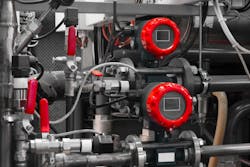Flow measurement represents as much as one-third of the overall sensor market, which is significant not only for plant balance but also because it’s how you get paid. Custody transfers require accurate measurements, while measurements used for control purposes require repeatability. Most manufacturers strive to make their devices accurate and repeatable, but are mindful of whether accuracy is stated as percent of reading or percent of scale.
Fortunately, international standards and practices have recommendations for minimum upstream and downstream pipe lengths, and manufacturers also reinforce this in their user manuals to provide guidance on associated installation best practices. Many documents assume measurement of a “perfect single-phase fluid,” which have no impurities, such as dirt, corrosion materials, or entrained gases or liquids. However, they’re part of the real world and found in any facility.
One critical factor in any flow measurement is gravity because heavier materials will be on the bottom, and we can use that information to make sure the sensor element is kept away from where gunk tends to accumulate.
Literature is available on how to improve the most historically, widely used orifice plate measurements, but other technologies also have their quirks. The following are some of the more interesting flow problems and solutions I encountered during my career, many because I worked in an extraction/mining environment containing solids and slurries. The solids ranged from rocks to micron-sized clay particles. Though there may not be rocks in your process, everyone has smaller particles from corrosion products to catalyst dust.
Vortex meters are more common, especially for liquid service. They operate off the von Karmon principle, which means the bluff body must be able to vibrate, so the embedded sensors can pick up the resulting frequency and correlate that to the flow rate. Unfortunately, this vibration can be a particularly good compactor, and pound small particles into the base receptacle as a solid, and cement in the bluff body. The solution is to keep the solids away from the bottom of the bar by rotating it between 15° and 45°, which means rotating by one bolt hole from vertical to 45° if the meter is flanged and larger than 3.5 inches.
The critical components in a magnetic flowmeter are the electrodes, which tend to not like being hit with large objects or sandblasted with smaller particles. The solution a deflector plate on the upstream face, which redirects the solids from the wall of the pipe to the center like a bug shield on a vehicle.
The most challenging measurement I worked on was a four-phase flow stream consisting of solids, oil/bitumen, water and air. Fortunately, the resulting measurement was for mass balance, so that a close but repeatable measurement was needed. We used two different technologies for this measurement.One was non-intrusive and strapped to the outside of the pipe. The other was a Venturi meter with cast-insert throat liners, so we could pull the meter from service and replace the liner without risk of losing pipe integrity.
These white iron cast liners weren’t as nice and smooth as a traditional Venturi, but they lasted several months between servicing intervals. We also used extended diaphragm differential pressure (DP) cells. However, rather than being flush, they were normally kept about ½-inch from flush, so the slurry wouldn’t impinge on them directly. They also didn’t have a large enough shelf on the nozzle for solids to accumulate on enough to bridge across the 3- or 4-inch nozzle and plug it.
Like any discipline, flow has its own lessons and experiences—often learned the hard way. Hopefully, sharing these experiences will provide food for thought on how similar problems can be solved.
About the Author

Ian Verhappen
Ian Verhappen

Leaders relevant to this article:
